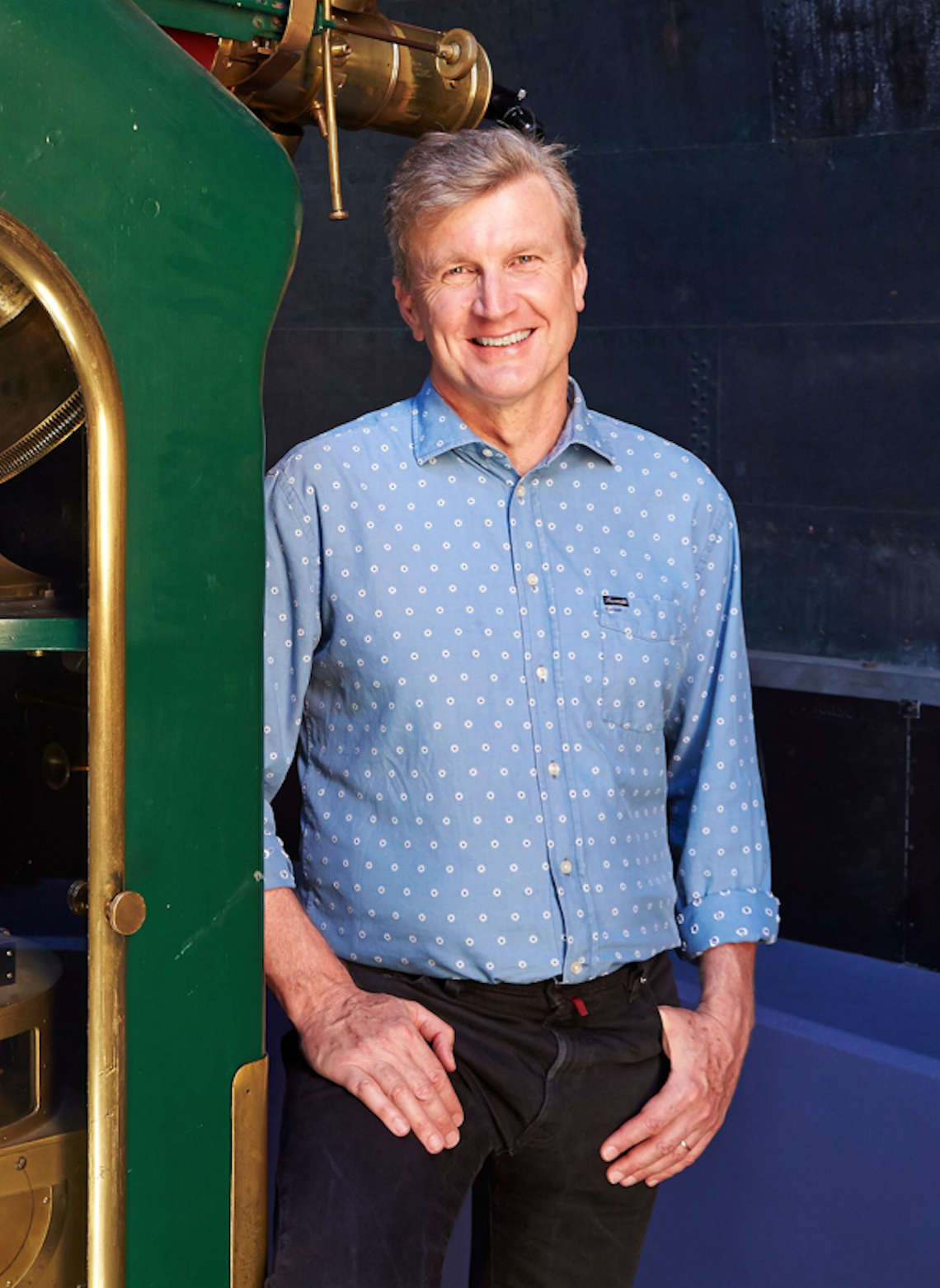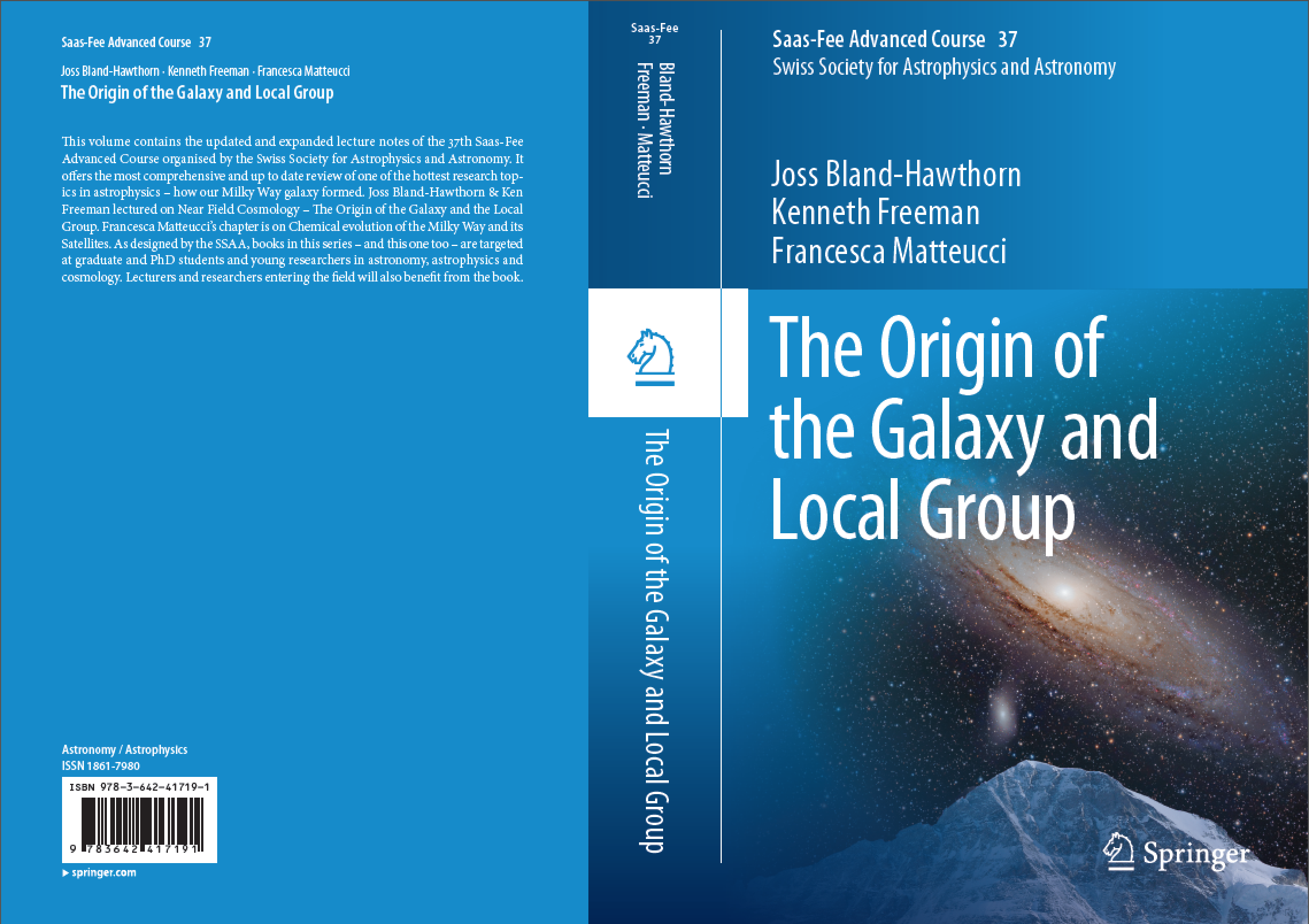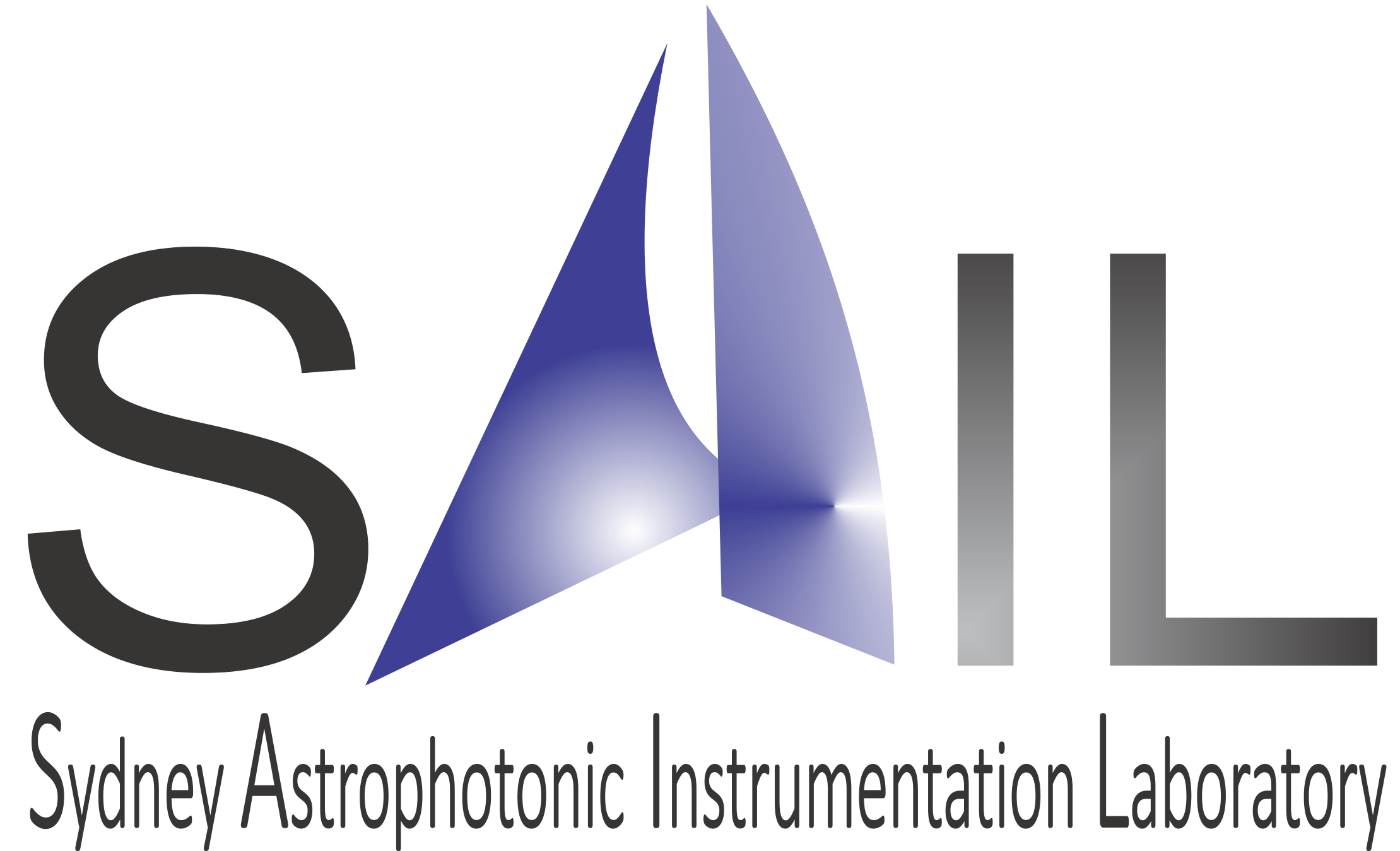Joss Hawthorn, University of Sydney @jossblandhawthorn
 |
Joss Bland-Hawthorn is an ARC Laureate Fellow Professor of Physics and Director of the Sydney Institute for Astronomy (SIFA). He
was born in England before moving overseas in 1985. After receiving his PhD from the Royal Greenwich Observatory and the University of Sussex, he took a 3-year postdoc in astrophysics at the Institute for Astronomy, University of Hawaii. In 1988-1993, he was a tenured professor at the Space Physics & Astronomy Department, Rice University, Texas. In 1993, he joined the Australian Astronomical Observatory, Sydney. In 2000, he was appointed Head of Instrument Science, a new division that was created to reflect the increasing need for complex novel solutions to astronomical instrumentation.
In 2007, Joss was awarded the prestigious Federation Fellowship with a tenured professorship in the Sydney Institute for Astronomy (SIfA), School of Physics, University of Sydney. In 2009, he co-founded the Institute of Photonics and Optical Science (IPOS).
In 2012, he was elected Fellow of the Australian Academy of Science and the Optical Society of America. In 2014, Joss was awarded the Australian Laureate Fellowship.
He has won numerous
awards
and serves on several boards including Section H (IAU) and the Annual Reviews of Astronomy and Astrophysics (USA). He has delivered...
...more...
...numerous lecture series (e.g. Saas Fee, Bologna, Wisconsin) and is a regular speaker on the conference circuit, in addition to delivering occasional addresses at schools, clubs and industry. He was the Canon Lecturer at Canon Inc, Shinegawa, Tokyo (2012), the Plenary Speaker at the Supreme Court Judges conference (2013), and the Allison Levick Lecturer (2009, 2014) and gave the address at the AAS Burbidge dinner in Auckland, NZ (2019). In 2019, a review by The Australian identified him as the research leader in astronomy and astrophysics. He is a regular guest at the University of Oxford, the University of Bologna and the University of Marseille.
|
For more background, see this December 2007 review in Gemini Focus or Profile of
an Australian Astronomer under the web pages of the Astronomical
Society of Australia. For media purposes, there is a high resolution
portrait available here.
Joss supervises a group of
Honours undergraduate students, MSc and PhD students, and Postdoctoral research
fellows. About half work in astronomy and astrophysics and the others
work on astrophotonics, space photonics and quantum astronomy
experiments. The Sydney Astrophotonic Instrumentation Labs (SAIL) are based at the School of Physics
on campus although a lot of shared activity takes place at Macquarie University
and the Australian Astronomical Observatory.
His group retains strong links
with activities at the Leibniz Institute for Astrophysics, Potsdam; the Department of
Astronomy, University of Maryland and NASA Goddard, and numerous other
linkages across Asia and Europe. There are about a dozen groups working
on programs that started life at the University of Sydney. In collaboration
with the Space Physics group, his team launched
the first balloon-based photonic experiment in November 2012; this
was followed by the first photonic satellite, the Inspire-2 cubesat sent to the International Space Station in April 2017, now in low-earth orbit.
His developments and patents are increasingly being exploited by
medical and telecomm companies, remote sensing and food industries.
Contact Details
E-mail: jbh@physics.usyd.edu.au
Phone: +61 2 9351 2621
Fax: +61 2 9351 7726
Postal Address: Prof. J. Bland-Hawthorn, Sydney Institute of Astronomy, School of Physics, University of Sydney, NSW 2006, Australia
Fedex Address: Prof. J. Bland-Hawthorn, School of Physics, University of Sydney, Camperdown, NSW 2006, Australia
Research Highlights
For web links to my research papers since 1984, astronomy papers via ADS are found here (full) or
here (low author count).
Instrumentation papers are found here through SPIE.
Optics papers are available
here through www.opticsinfobase.org.
My most recent patent can be found here.
...more...
- Near-field Cosmology
- Galactic archaeology
- Galactic dynamics
- Chemical tagging
- Ultra-faint dwarf galaxies
- First stars: chemical signatures
- Far-field Cosmology
- First stars: formation and evolution
- First galaxies: formation and evolution
- Intergalactic medium and metagalactic radiation
- Galaxy accretion processes: stars, gas
- Galaxy feedback mechanisms: winds, jets, radiation
|
-
Astrophotonics, Space Photonics & Quantum Astronomy
- photon orbital angular momentum
- ultrabroadband fibre Bragg gratings
- integrated photonic spectrographs
- hexabundles & photonic lanterns
- 3D spectrographs
- tunable imaging filters
- Fabry-Perot interferometers
- integral field spectrographs
-
Differential techniques
- OH suppression
- nod & shuffle, charge shuffling
|
Near field cosmology
 This is a field of astrophysics I have developed with Ken Freeman since 1999;
a text book on the topic is now well advanced.
You may wish to see a review I wrote
with Ken Freeman on "The Baryon Halo of the Milky Way" (Science,
Jan 2000) or a related article in
"Clues to Galaxy Formation" (Nature, July 1999). Both articles
show the time is ripe for a general convergence of far-field cosmology
and near-field cosmology (cosmogony). I explore these topics further here:
2002 Annual Reviews article,
2007 Saas Fee lectures,
2016 Annual Reviews article.
An updated and extended version of the 2007 lectures was published
in 2013; we provide download details below.
...more...
This is a field of astrophysics I have developed with Ken Freeman since 1999;
a text book on the topic is now well advanced.
You may wish to see a review I wrote
with Ken Freeman on "The Baryon Halo of the Milky Way" (Science,
Jan 2000) or a related article in
"Clues to Galaxy Formation" (Nature, July 1999). Both articles
show the time is ripe for a general convergence of far-field cosmology
and near-field cosmology (cosmogony). I explore these topics further here:
2002 Annual Reviews article,
2007 Saas Fee lectures,
2016 Annual Reviews article.
An updated and extended version of the 2007 lectures was published
in 2013; we provide download details below.
...more...
First stars, first galaxies, dwarf galaxies.
After an Aspen Winter School on Local Group Cosmology in Feb 2006, Jim
Peebles and I wrote an update on this
topic where we discuss the idea that the most ancient stars may be hiding near
the Galactic Centre and therefore will be very challenging to identify. More
recently, I have written a 2013 Reviews of Modern Physics article on the
chemistry of the first stars with Torgny Karlsson and Volker Bromm.
In collaboration with Ralph Sutherland,
I am working on the evolution of dwarf galaxies in the Galactic halo and the
formation of the first dwarf galaxies.
Million star surveys.
Some of the most exciting developments are the huge stellar surveys under
way in Australia, Europe and the USA. I am a co-founder of the RAVE survey
at the UK Schmidt Telescope (Australia) which completed its last
observations in early 2013. I am also a co-founder of the HERMES instrument and associated galactic archaeology survey (GALAH)
which started in Feb 2014. The most
anticipated of them all is the astonishing billion-star astrometric
Gaia survey from ESA which launched successfully in Dec 2013.
Galaxia.
A major development at the University of Sydney is the
Galaxia code by
Research Fellow Sanjib Sharma. This synthetic framework for the Galaxy
has been used extensively to understand the Geneva-Copenhagen, Segue
and RAVE stellar surveys. It allows for the different surveys to be
cleaned up, to be intercompared and to be compared to a theoretical framework.
Parameter estimation is possible through the use of two kinds of Markov
Chain Monte Carlo (MCMC) techniques. The hierarchical and stochastic MCMC
methods allow for fine (small errors, multiple solutions possible) and
coarse (larger errors, full mapping of the parameter space) sampling
respectively.
The code also allows the stellar surveys to be compared to N-body simulations.
To witness the power of this approach, see our
recent study
of 200,000 stars from the RAVE survey. We are now starting a full-blown study
of the billions of stars within the 2MASS and APASS catalogues, and ultimately
the Gaia catalogue (2019).
Disk galaxies.
Here is a series of audio files where I describe
recent work on the closest disk galaxy beyond the Local
Group. In 2005-2011, we presented evidence in the Astrophysical Journal that
the galaxy stellar disk extends twice as far as was previously
believed. Moreover, the outer disk shows a peculiar trend in the stellar
abundances. Using the Gemini South telescope, we reach equivalent
surface brightness levels that have never been achieved before. The
full news story is available at this site.
Galactic Centre explosion.
In 2003, Martin Cohen and I discovered a large-scale wind from the Galactic Centre.
This preempted the marvellous Fermi discovery of the gamma-ray bubbles in
2010 over the same physical scale (+/-50 degrees!). At the time, we were unclear
whether the explosion was driven by a starburst or by a supermassive black hole.
But in 2013, we discovered that the Galaxy underwent a full-blown Seyfert
phase just two million years ago, i.e. when Homo Erectus walked the Earth!
This means that the well-established supermassive black hole at the Galactic Centre
(Sgr A*) was blasting bipolar jets at full power only recently in cosmic terms.
Of course it's the accretion disk that swirls around the black hole that does this,
not the black hole itself. This story had major press coverage in September 2013.
The best description of the work is the
New Scientist feature article.
A link to my TV interview is given below.
Gas accretion onto galaxies.
A great deal of my work has focussed on how gas gets into galaxies. Our
large Hubble Space Telescope programme (Fox et al 2013, 2014) targets 70 quasars
seen through the Magellanic Stream. These background sources allow us to see the
imprint of a rich forest of UV absorption lines across the Galactic halo. We have
begun to probe the Galactic wind region using the same method.
A new generation of galaxy surveys
Australia has a long history in galaxy redshift surveys. The highly
successful Two Degree Field Galaxy Redshift Survey brought home to me
the limitation of one-fibre-per-galaxy instruments. Much of the light
from the galaxy is missed because of the small aperture. Then in 2005,
Simon Ellis and co-workers demonstrated convincingly that aperture effects
were inherent in all such surveys. This led to the development of the
hexabundle (a closely packed, cladding reduced fibre bundle) starting
in late 2007 and ultimately to the
Sydney-AAO Multi-object Integral Field Spectrograph (SAMI) instrument.
The technology was first presented at the Dunk Island and ESO conferences
in 2008. The SAMI survey team of 110 astronomers across 30 institutions
is led by Scott Croom (University of Sydney).
The ongoing SAMI technology development is being carried out by Jon Lawrence
(AAO) and in the SAIL labs by Julia Bryant and Sergio Leon-Saval
(University of Sydney).
The SAMI Galaxy Survey has the goal to obtain integral field data for 3600 galaxies by 2017. Related surveys are the ATLAS3D, CALIFA and Manga projects in
Europe, Mexico and the USA.
Over the next few years, we are engaged in a much larger instrument - the Hector
project - that will obtain similar data for 100,000 galaxies over the
remainder of the decade.
A new generation of astronomical instruments
 SAIL has completed or is developing a range of novel astronomical
instruments: SAMI, Hector, HERMES,
GNOSIS, PRAXIS, MOHSIS, Pandora, Dragonfly, i-INSPIRE, PIMMS. SAMI is a major dark-time facility awarded 180 nights at the AAT to observe 3400 galaxies using integral field spectroscopy. This is to be extended to 100,000 galaxies with
the automated Hector instrument in 2018. HERMES is a major bright-time facility at the AAT with the primary goal to observe a million stars using high-resolution spectroscopy over five years.
SAIL has completed or is developing a range of novel astronomical
instruments: SAMI, Hector, HERMES,
GNOSIS, PRAXIS, MOHSIS, Pandora, Dragonfly, i-INSPIRE, PIMMS. SAMI is a major dark-time facility awarded 180 nights at the AAT to observe 3400 galaxies using integral field spectroscopy. This is to be extended to 100,000 galaxies with
the automated Hector instrument in 2018. HERMES is a major bright-time facility at the AAT with the primary goal to observe a million stars using high-resolution spectroscopy over five years.
My interest in photonics started in
1999 when talking to Martin Harwit about the prospects of improved
space communications. We were struck by how only a fraction of the potential data from
space missions were getting back to Earth, even allowing for data compression.
In 2002, I wrote two papers on "Laser Telemetry from Space" with
father and son team, Martin & Alex Harwit (Science, July 2002). The papers were adopted as a NASA white paper in
that same year and a workshop was held at JPL to discuss the work.
My team at the AAO formed the Australian Centre for Space Photonics to pursue funding
avenues. This led to a second NASA visit to Australia to attend the IAU 2003
where a special session was held on laser communications.
In early 2006, and sooner than I had anticipated, a NASA Goddard
team achieved the first interplanetary laser communications over a
distance of 24 million km (Science,
Jan 2006). With reference to our work, their paper describes how they used
the MESSENGER satellite which is on a 6.6 year voyage to Mercury and
due to arrive in early 2011. For more information, see our
laser comms website.
...more...
Since 2001, my group has explored the use of photonics in
astronomical and space instrumentation -- a field now known as
astrophotonics.
Most papers can be accessed through opticsinfobase. Optics Express highlighted the field of astrophotonics
in a special issue (12 papers) in Feb 2009; astrophotonics and space photonics were also featured in
2012 Physics Today article.
The field has received special sessions at EOS (Europe)
and OSA (USA) optics conferences. Some of our new technologies were tested
on our first balloon experiment in November 2012.
The field of quantum optics is finding increasing relevance and overlap
with astronomy. The field originally grew out of Hanbury Brown's
astronomical projects (Sydney, Manchester) in the 1950s and 1960s.
In this respect, quantum astronomy has been with us for a long time although
little has happened since the early analogue experiments. In recent years,
there has been a steady rise in quantum astronomy in large part due to the
prospect of single photon detection at picosecond rates (SPADs, SiPMs)
and the promise of AO-assisted extremely large telescopes.
At Sydney and Macquarie, we have begun to investigate photon orbital angular
momentum and related phenomena.
Downloads
Books.
Here is a list of technical books
I have written.
Popular & technical talks.
Here is a list of popular and technical science talks from
the last few years. I have not listed more general talks on
science policy, women in science, technology in education, how
to write grants and review papers, and so forth.
Popular articles.
Here is an incomplete list of popular
articles over the past few years.
Media interviews.
Here is an incomplete list of media
interviews over the past few years.
Old links.
list.
Last updated: Oct 2016
Joss Hawthorn (jbh@aao.gov.au)

 This is a field of astrophysics I have developed with Ken Freeman since 1999;
a text book on the topic is now well advanced.
You may wish to see a review I wrote
with Ken Freeman on "The Baryon Halo of the Milky Way" (Science,
Jan 2000) or a related article in
"Clues to Galaxy Formation" (Nature, July 1999). Both articles
show the time is ripe for a general convergence of far-field cosmology
and near-field cosmology (cosmogony). I explore these topics further here:
2002 Annual Reviews article,
2007 Saas Fee lectures,
2016 Annual Reviews article.
An updated and extended version of the 2007 lectures was published
in 2013; we provide download details below.
...more...
This is a field of astrophysics I have developed with Ken Freeman since 1999;
a text book on the topic is now well advanced.
You may wish to see a review I wrote
with Ken Freeman on "The Baryon Halo of the Milky Way" (Science,
Jan 2000) or a related article in
"Clues to Galaxy Formation" (Nature, July 1999). Both articles
show the time is ripe for a general convergence of far-field cosmology
and near-field cosmology (cosmogony). I explore these topics further here:
2002 Annual Reviews article,
2007 Saas Fee lectures,
2016 Annual Reviews article.
An updated and extended version of the 2007 lectures was published
in 2013; we provide download details below.
...more...
 SAIL has completed or is developing a range of novel astronomical
instruments:
SAIL has completed or is developing a range of novel astronomical
instruments: